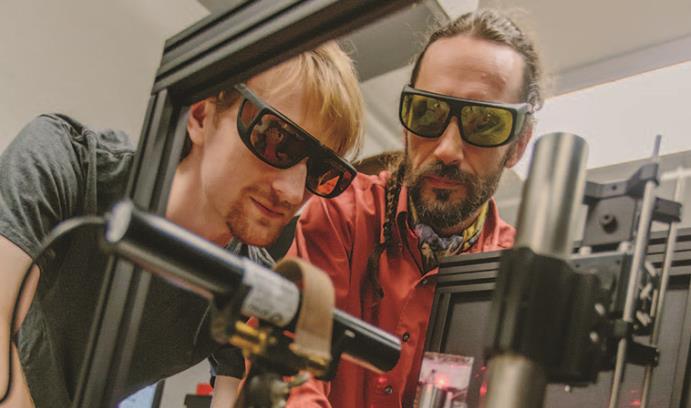Mapping the strain in a wonder material

Michael Blades (left), a graduate student in physics, works with Rotkin on a new optics system that he built in Rotkin’s lab. Rotkin is part of an international research group that is using spectroscopy and statistical analysis to study the properties of graphene.
Graphene is the thinnest material known to science, and one of the strongest as well. A 1-atom-thick sheet of carbon, graphene was the first 2D material ever discovered. By weight, it is 150 to 200 times stronger than steel. It is also flexible, dense, virtually transparent and a superb conductor of heat and electricity.
An international research group has reported a breakthrough in the effort to characterize the properties of graphene noninvasively while acquiring information about its response to structural strain.
Using Raman spectroscopy and statistical analysis, the group took nanoscale measurements of the strain present at each pixel on the material’s surface and obtained a high-resolution view of the chemical properties of graphene’s surface.
The results, says Slava V. Rotkin, could enable scientists to monitor levels of strain quickly and accurately as graphene is being fabricated. This in turn could help prevent the formation of defects that are caused by strain.
“Scientists already knew that Raman spectroscopy could obtain implicitly useful information about strain in graphene,” says Rotkin, a professor of physics in Lehigh’s College of Arts and Sciences with a dual appointment in the department of materials science and engineering. “We showed explicitly that you can map the strain and gather information about its effects.
“Moreover, using statistical analysis, we showed that it is possible to learn more about the distribution of strain inside each pixel, how quickly the levels of strain are changing, and the effect of this change on the electronic and elastic properties of the graphene.”
The group reported its results in Nature Communications in an article titled “Raman spectroscopy as probe of nanometer-scale strain variations in graphene.” In addition to Rotkin, the article was authored by researchers from RWTH/Aachen University and the Jülich Research Centre in Germany, the Université Paris in France, Universidade Federal Fluminense in Brazil, and the National Institute for Materials Science in Japan.
Graphene has found its way into applications ranging from tennis rackets to smartphone touch screens. The 2013 market for graphene in the U.S., according to a 2014 article in Nature, was estimated at $12 million.
Among the obstacles holding up further commercialization of graphene is the presence of defects that impose strain on graphene’s lattice structure and adversely affect its electronic and optical properties. Related to this is the difficulty in producing high-quality graphene at low cost and in large quantities.
Posted on:

